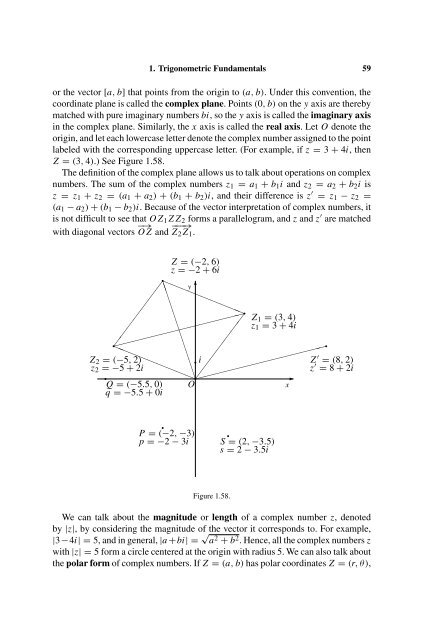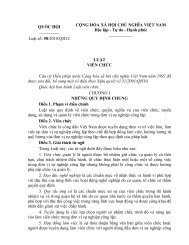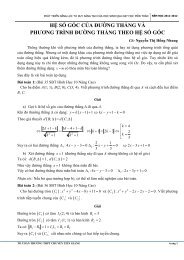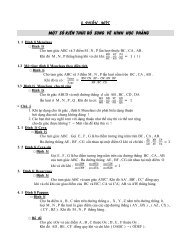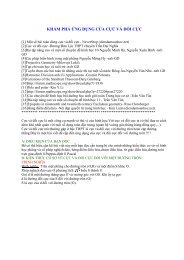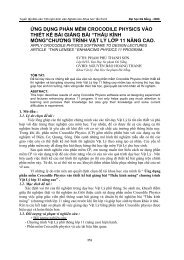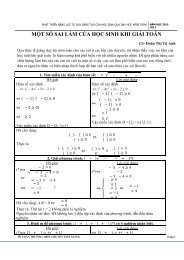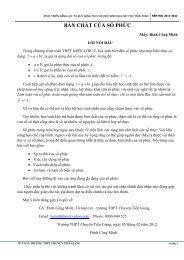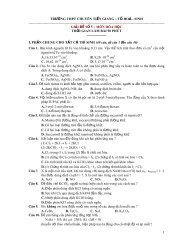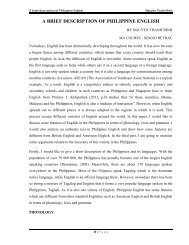103 Trigonometry Problems
103 Trigonometry Problems
103 Trigonometry Problems
Create successful ePaper yourself
Turn your PDF publications into a flip-book with our unique Google optimized e-Paper software.
1. Trigonometric Fundamentals 59<br />
or the vector [a,b] that points from the origin to (a, b). Under this convention, the<br />
coordinate plane is called the complex plane. Points (0,b)on the y axis are thereby<br />
matched with pure imaginary numbers bi,sothey axis is called the imaginary axis<br />
in the complex plane. Similarly, the x axis is called the real axis. Let O denote the<br />
origin, and let each lowercase letter denote the complex number assigned to the point<br />
labeled with the corresponding uppercase letter. (For example, if z = 3 + 4i, then<br />
Z = (3, 4).) See Figure 1.58.<br />
The definition of the complex plane allows us to talk about operations on complex<br />
numbers. The sum of the complex numbers z 1 = a 1 + b 1 i and z 2 = a 2 + b 2 i is<br />
z = z 1 + z 2 = (a 1 + a 2 ) + (b 1 + b 2 )i, and their difference is z ′ = z 1 − z 2 =<br />
(a 1 − a 2 ) + (b 1 − b 2 )i. Because of the vector interpretation of complex numbers, it<br />
is not difficult to see that OZ 1 ZZ 2 forms a parallelogram, and z and z ′ are matched<br />
with diagonal vectors −→ OZ and Z −−→<br />
2 Z 1 .<br />
Z = (−2, 6)<br />
z =−2 + 6i<br />
<br />
❛<br />
✓❇❇<br />
❛❛❛❛❛❛❛ y ✻<br />
✓ ❇<br />
✓ ❇<br />
❛ <br />
✓ ❇<br />
Z 1 = (3, 4)<br />
✓ ❇<br />
z 1 = 3 + 4i<br />
<br />
<br />
❛❛ ✓ ✓ ✓ ✓<br />
✓<br />
❇<br />
✘✘ ✓<br />
✘✘ ✘✘ ✘ ✘✘✘ ✘ ✘ ✘ ❇<br />
❛❛❛❛❛❛❛✓<br />
Z 2 = (−5, 2) ❇ i<br />
Z ′ = (8, 2)<br />
z 2 =−5 + 2i ❇<br />
z ′ = 8 + 2i<br />
<br />
<br />
✓✓ ❇✘ ✘ ✘ ✘✘✘ ✘ ✘ ✘ ✘ ✘ ✘✘ ✘<br />
✲<br />
Q = (−5.5, 0) O<br />
x<br />
q =−5.5 + 0i<br />
<br />
P = (−2, −3)<br />
p =−2 − 3i<br />
<br />
S = (2, −3.5)<br />
s = 2 − 3.5i<br />
Figure 1.58.<br />
We can talk about the magnitude or length of a complex number z, denoted<br />
by |z|, by considering the magnitude of the vector it corresponds to. For example,<br />
|3−4i| =5, and in general, |a +bi| = √ a 2 + b 2 . Hence, all the complex numbers z<br />
with |z| =5 form a circle centered at the origin with radius 5. We can also talk about<br />
the polar form of complex numbers. If Z = (a, b) has polar coordinates Z = (r, θ),


